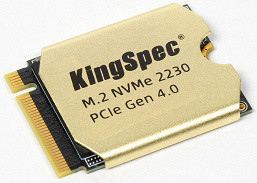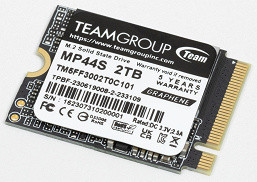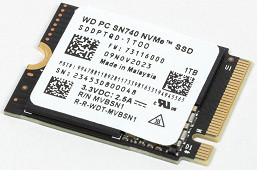Under any article dedicated to «fast flash drives», be it modern flash memory controllers (not much different from those used in budget SSDs), UFS modules or budget SSDs with a USB bridge, compactly packed into small cases, comments inevitably appear in the spirit of: «for this money, it is better to assemble an external SSD from an M.2 drive and a special case.» There is some truth in this, but not as significant as it may seem at first glance.
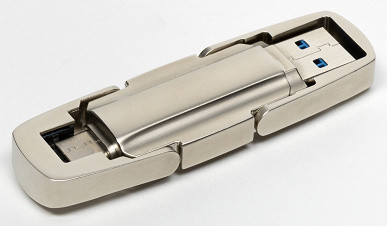
One of the important aspects that is often not taken into account is the size of the device, which is a critical characteristic for consumers. A compact finished flash drive (even if it is not really a flash drive in essence) always poses a risk for the manufacturer. The production of typical SSDs is easy to set up — they are in demand in huge volumes for various purposes. But SSD boxes have a limited audience, but this is not so scary: their cost is low, and they can be sold for a long time. For example, USB-NVMe bridges with USB 3.2 Gen2 support appeared back in 2019 and remain relevant. Cases based on them are still used, only more modern SSDs are now installed in them. However, to release a ready-made compact drive, the manufacturer needs to accurately predict demand. The cost of flash memory decreases over time (albeit unevenly), so it is impossible to make such devices «for the warehouse» — if something is already assembled, it is impossible to disassemble it back. This niche is small, so it is most often dealt with by small companies that seek to quickly recoup their investments. It's easier for big brands — there is demand for flash drives, but the mass buyer often does not differentiate between fast and slow models, but is guided mainly by the brand's popularity. As a result, their devices can be boring and uninteresting. What we regularly test is needed only by demanding buyers who know exactly why they need it, so such devices are more expensive. An external SSD assembled from an M.2 drive and a case will always be noticeably cheaper than a ready-made external SSD in the format of a compact flash drive.
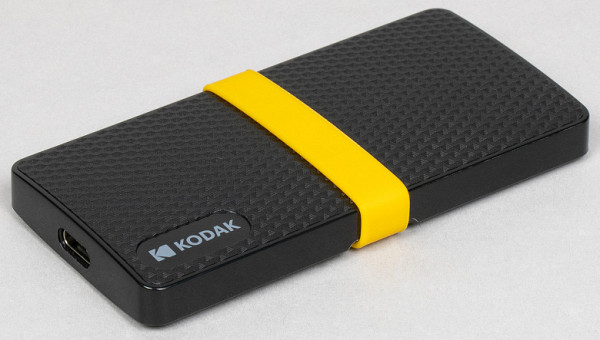
The second important aspect that is often overlooked is how such an assembly will function in practice. We have repeatedly demonstrated that turning a budget SSD into an external device is the worst option for it. It would seem that a system drive should cope with more complex tasks than an external drive, and the speed of external interfaces is always lower than internal ones, which should limit the potential. However, programmers have long been successfully solving these problems. For example, SLC caching over the past 10 years has learned to effectively hide memory deficiencies when writing until the cache is exhausted. For a system drive, this is not critical, since small amounts of data are usually written to it, which easily fits into the cache. But an external drive is bought in order to write large amounts of data, sometimes even filling it completely at one time. At the same time, the cache capacity is only 25% — 40% of the total volume, and budget controllers write the remaining data very slowly, which leads to noticeable problems in the write speed. Conventional benchmarks, such as CrystalDiskMark, do not display these shortcomings, since they only test the operation of the SLC cache. And if buying a ready-made external SSD with such problems leaves the opportunity to blame the manufacturer, then when assembling it yourself, the responsibility falls entirely on you.
Assembling an external SSD with your own hands is a completely justified process. You control it completely and can do everything correctly. In addition, it is usually cheaper than buying a ready-made device of the same level, since manufacturers strive to earn more on this. But you will have to sacrifice compactness. An external SSD based on M.2 2280 can be considered compact only in comparison with external hard drives, since such devices are usually at least 10 cm long and 3 cm wide. In addition, you will need a separate cable, which itself can be comparable in size to a flash drive. Cases with a built-in USB connector are available, but we do not recommend them: such devices can interfere with access to neighboring ports and are easily damaged. Thus, a compact flash drive is more convenient, but the cable option will be much faster.

However, the standard form factor is not the only solution; there are also more compact options. Let us remind you that the M.2 format includes drive sizes from 2230 to 22110, i.e. the minimum length of the board can be only 30 mm. There are also cases for such compact drives; they are much smaller than for the 2280 format. But you can’t do without compromises here either. Firstly, you will have to give up fast external interfaces: manufacturers still ignore even USB3 Gen2×2, not to mention Thunderbolt or USB4. Secondly, the choice of “small” SSDs is much narrower compared to “full-size” ones, and fast ones are extremely rare among them. Given this, high-speed interfaces may not make sense. In addition, one of the main applications of such compact boxes is to use the drive left over after upgrading a laptop. A laptop SSD usually has a small capacity and speed, so there is no point in spending money on an expensive box for it. But buying an inexpensive box is a completely logical option, since there are almost no other ways to use such SSDs except turning them into external drives.
However, you can assemble such a solution from scratch, taking into account all possible difficulties in advance. Why? Just look at the photo above. At the same time, the USB3 Gen2 interface, despite its age, remains relevant, since even now there are computers that do not support anything faster. The main task is to use the available capabilities as efficiently as possible without overpaying. This will require careful selection of SSDs, and, as already mentioned, a drive that works well as a system drive will not necessarily be successful as an external one. Therefore, today we will consider three typical examples that actually cover the entire range of existing solutions. The findings will help you navigate your choice, just as Archimedes looked for a fulcrum to turn the Earth.
iRhasta M.2 NVMe SSD Enclosure Box Case for 2230 – form
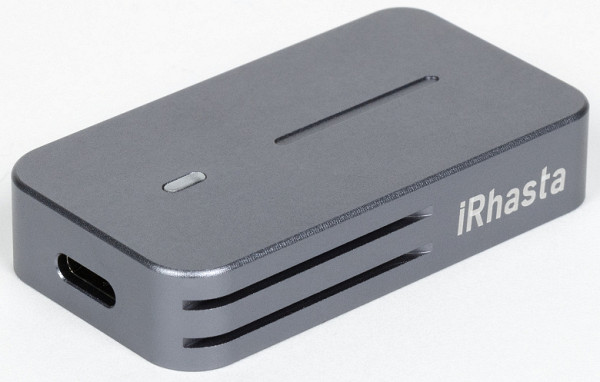
For obvious reasons, it is better to go straight to AliExpress for such specific goods — such small-circulation exotics are rarely found in regular stores, which is compensated by the prices :) The choice of a specific box is not so important, because they are all approximately the same both in appearance and in internal structure. Basically, they resemble their «large» counterparts, only in a miniature format.
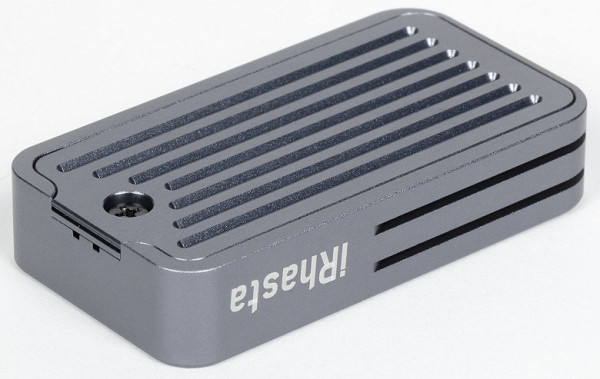
In this case, the dimensions are 52×28×10 mm with a weight of 24 g (without SSD). You can also consider 2242 format drives — then the length will increase to 6 cm, but the choice of SSD will be slightly wider. There are models with a built-in USB port, however, in our opinion, such dimensions are still not so compact that you can refuse to use a cable.
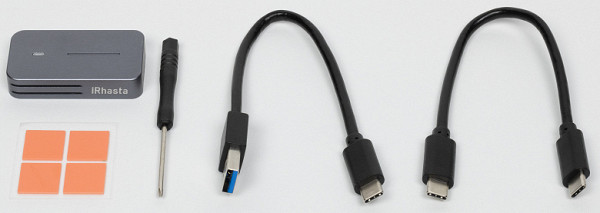
The kit includes two cables: A-C and C-C, both 20 cm long, which is convenient for working with laptops, but may seem insufficient to desktop PC users. Long cables can be purchased separately, but it is worth paying attention to the supported data transfer rates. Cheap cables are usually designed for charging phones and are limited to the USB 2.0 standard, which is not suitable for serious tasks. Therefore, it is better to choose a “high-speed” cable with high-quality power support. With a short length, this is easy to implement, so such cables are often found in inexpensive kits. More expensive solutions may have higher quality, but overpaying for this up to 100% of the cost of the device is a question worth considering. The kit also includes thermal pads for cooling and a screwdriver. All that is needed additionally is the SSD itself.
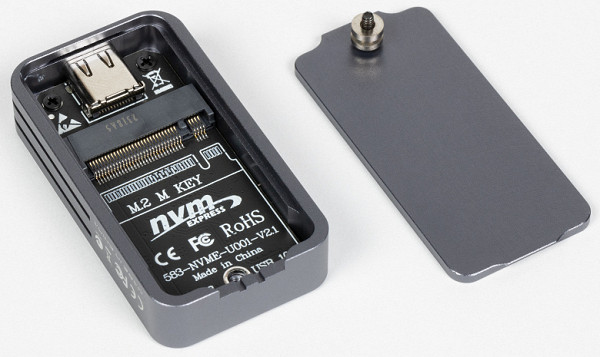
The structure is secured with one screw, which simultaneously fixes the cover and the drive itself inside. This is not the most convenient solution, since the cover has to be held carefully so that it does not shift. However, this solution was chosen for the sake of compactness — if the fasteners were separate, the dimensions of the device would increase.
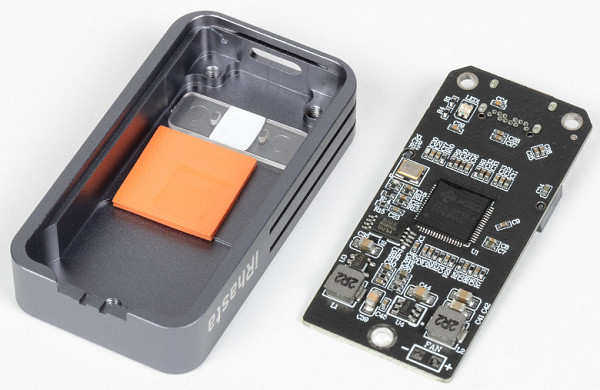
By unscrewing two screws inside the case, you can remove the board and see the controller. There are two main options: JMicron JMS583 and Realtek RTL9210B. We have studied both in detail, and there are two important differences: RTL9210B also supports SATA drives, but is slightly more expensive. Nowadays, using SATA only makes sense if you already have such a drive in the required form factor and need to use it — this will save you a little. When installing an NVMe drive, both bridges work almost the same. They are limited by the USB 3.2 Gen2 interface speed to 10 Gbps, which in practice gives about 1 GB/s. If you can find a model with a faster controller, the speed may be higher. We have not yet been able to find such options, and there was no need, because such cases cost about 1,000 rubles. With the right choice of SSD, you can get higher performance than ready-made external drives of similar capacity. Fast bridges significantly increase the cost, but it is difficult to use their potential, especially due to the limitations of the external environment.
In the end, all that remains is to install the SSD — and you can work. The main thing is to choose the right drive.
KingSpec XF-1TB 2230 1TB, TeamGroup MP44S 2TB and WD PC SN740 1TB - Contents
We didn't have a large selection of SSDs in this rather exotic form factor, but three models were recently tested using the standard methodology. All of them support PCIe Gen4, so using them with an external interface whose throughput is almost an order of magnitude lower seems irrational. However, we, like many others, are more interested in real speeds, which are often far from the capabilities of modern internal interfaces, especially in the budget segment.
TeamGroup MP44S uses QLC memory, so you shouldn't count on high speeds from the start. However, at the moment, this is one of the few ways to pack 2 TB into such a compact size. The SN740 and its retail counterpart WD Black SN770M may be suitable, but they are quite expensive. In general, the WD line is not cheap, although the OEM version of the SN740 can be found at a more attractive price, but only in a terabyte capacity due to high competition in this segment. Chinese companies are also active here, which gave us the third SSD. From a technical point of view, our test SSDs are interesting for their different approaches to SLC caching: only the KingSpec XF implements direct recording to TLC, while TeamGroup and WD use a cache on all free cells. However, this scheme is applicable to memory with different native speeds, which can play an important role. How exactly — the tests will show.
Testing
Testing methodology
We use a test bench based on the Intel Core i9-11900K processor and the Asus ROG Maximus XIII Hero motherboard with the Intel Z590 chipset, which provides full support for all USB 3.2 speed modes, including Gen2×2.
The NTFS file system was used for all tested devices. Write caching for USB drives is enabled in cases where it is supported. For flash drives (even high-speed ones), this function is usually not available, while for external SSDs and hard drives it works. And it is better not to neglect it.
Filling in data
We will present the results for each SSD in pairs — internal connection and operation via USB. This allows us not only to compare them with each other, but also to see how much we lose by switching to a slow (by modern standards) external interface. Let's start with the slowest drive in all respects.
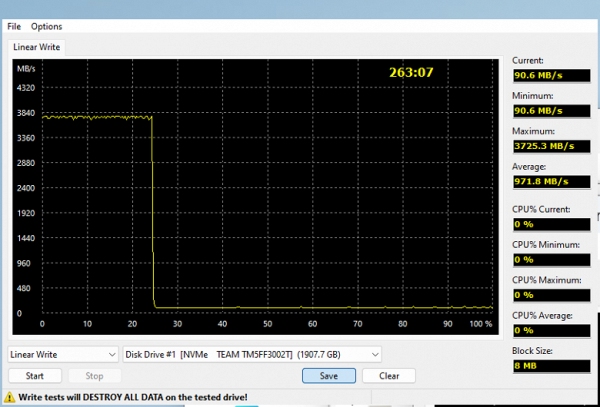
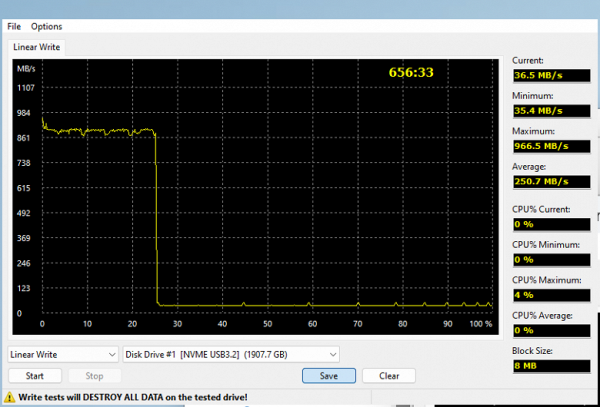
It is immediately obvious that the slow interface significantly limits performance. The write speed to the SLC cache cannot exceed a certain limit, so the maximum speed dropped four times, and the minimum — almost three times. When connected directly, the SSD after the cache was exhausted slowly accepted new data, pushing old data at a speed of about 90 MB/s, which is already quite low. Via USB, this speed dropped to 35 MB/s. As we warned, switching to an external interface is the worst thing that can happen to budget platforms. But is it only for them?
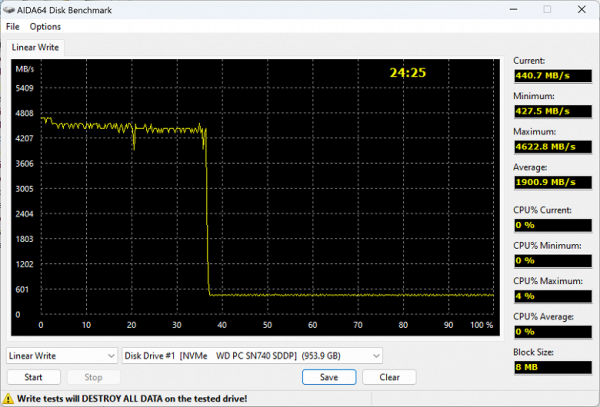

The caching issues are not limited to budget devices, but also to faster models. While the write speed to the cache is clear, the process of “raking” the data also slows down a bit. However, the results look much better overall – the total test execution time increased by only a third, not three times. Two-thirds of the drive is not written at full interface speed, but still quite fast compared to many alternatives. QLC memory demonstrates normal speeds only when writing to the cache – no one doubts that.
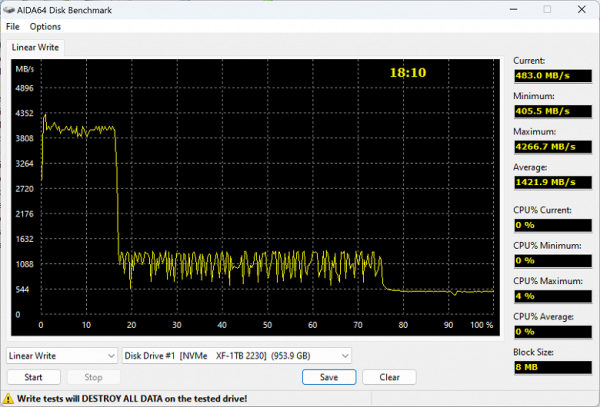

The cache here is small, but its influence is noticeable by the flat graph. Under normal conditions, direct recording reaches a speed of about 1 GB/s, which almost matches the capabilities of USB3 Gen2. It would seem that this should be our result, but in fact we get a speed that is one and a half times less. The cache still needs to be cleared out, although it did not help much at the beginning. As a result, we come to the finish line almost simultaneously with the WD PC SN740, although with a direct connection, the KingSpec XF was faster. As we have already noted, both schemes have their pros and cons — a large SLC cache is easier to «not notice», but errors in this case are more seriously punished. In the context of the main question, it is worth noting that it is not always necessary to count minutes or even a dozen or two minutes, especially against the background of hours spent by SSDs with QLC memory. The «internal» interface does not play a significant role here, and the external one only aggravates the problems. The results with Intel's QLC would be less dismal quantitatively, but the quality would still be in hours. Everything works fine as long as we stay inside the SLC cache.
Working with large files
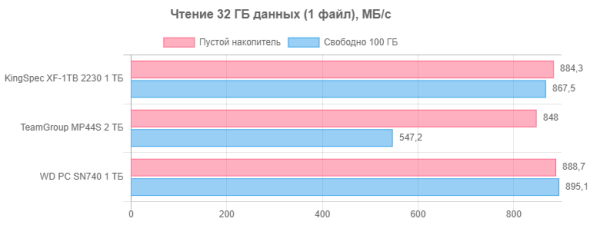
Modern SSDs easily handle gigabytes per second when reading data sequentially. It would seem that what could go wrong when the interface is limited to just one gigabyte per second? A lot. Firstly, most modern interfaces are not loaded to full capacity in one stream. Secondly, the internal nuances of the operation of the bridge bundles and drive controllers are important. For example, the Phison E21T reads data from the SLC cache much faster than from the main QLC array — this proportion is preserved when switching to USB. Inside the computer, the MP44S shows 2.6 and 1.8 GB/s in this test, and via USB — 848 and 547 MB/s. In absolute figures, this is quite good, but most users count on the former values. The other two test participants are fine with this.

The interface in multi-threaded mode can load data at full capacity, if… there is no problem with the «staleness» of the data. Inside the computer, you can ignore it, since the speed is still high. However, USB3 Gen2 is not so fast by default, so such a proportional decrease in speed can be an unpleasant surprise. Benchmarks that work only with data from the SLC cache will not demonstrate this problem.

Even if the entire file fits in the cache, the single QLC SSD still lags behind its competitors by a small amount. If the file doesn't fit in the cache, the lag becomes even more noticeable. The more data needs to be written outside the cache, the greater the lag.
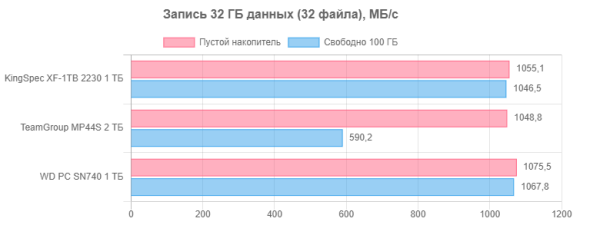
Multi-threaded write mode for external SSD demonstrates the same synthetic nature as multi-threaded read. The problems remain the same. This is not just a coincidence, but a repetition of already known trends.
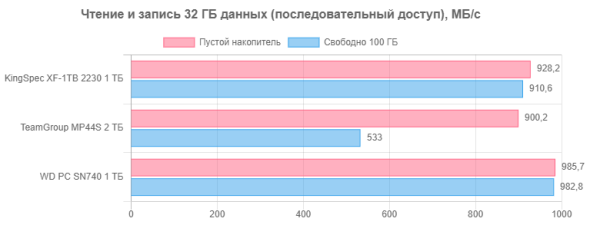
Reading and writing causes the same problems as writing itself. Although when testing TeamGroup MP44S on 2 TB we will see significantly higher results. However, the speeds in both modes also differ, and when the interface slows down, they change almost proportionally.
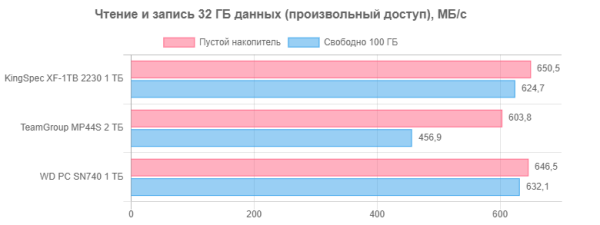
The most challenging scenario for external drives exposes the limitations of the interface itself, but in different ways. For mid- and high-end models, it's simply the interface limitation that sometimes makes it hard to tell the difference between them. Budget QLC SSDs have it much worse. Or at least it seems that way, as long as all the data ends up in the cache.
Comprehensive performance
At the moment, the best comprehensive benchmark for storage devices is considered to be PCMark 10 Storage, a brief description of which can be found in our review. We noted that the three tests in the set are not all equally useful — the most informative is the «full» Full System Drive, which covers almost all mass scenarios, from loading the operating system to simple copying of data (internal and external). The other two tests are only its subsets and, in our opinion, are not very interesting. This test is useful because it allows you to accurately measure not only the real throughput when performing practical tasks, but also the delays that occur. Although averaging these metrics is a bit synthetic, it provides more realistic estimates in general, and not just in specific cases. Therefore, it makes sense to familiarize yourself with it, even if it may seem redundant for evaluating «full-size» and non-budget external SSDs. For many owners, using an external drive instead of or together with an internal one still seems like a revolutionary idea. Those who do not share this opinion most often know how to choose (or assemble) the right models. However, for a quick assessment and comparison of subjects, this test is well suited, so it should not be ignored.
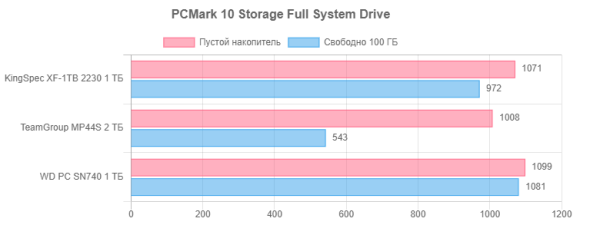
The test also shows that using QLC memory in such scenarios is impractical. The smaller SLC cache in the KingSpec XF-1TB 2230 is slightly inferior to the WD PC SN740 when space is limited (in this test, the «cache on all cells» strategy turns out to be optimal), but still matches the level of the best SATA SSDs, which is still quite sufficient for many users. Accusations of its «insufficiency» are often the result of the placebo effect. TeamGroup MP44S behaves like budget SATA SSDs, with all their shortcomings. However, with normal SLC caching, it can even work faster in a USB box, although it can be slower with interference. This is not critical, but possible. Receiving such a «gift» from the manufacturer of a ready-made external SSD is one thing, and assembling it yourself is quite another.
Total
We generally do not recommend purchasing a QLC SSD without a good reason. In general, such drives cope well with most typical tasks for the average user, and in some cases, such as an additional SSD in a gaming computer, the savings may be justified. However, an external SSD is a different story. Here, the disadvantages of four-bit memory are more obvious, since external drives are often used to write and transfer large amounts of data, where caching does not help. Such SSDs are also ineffective as a “boot flash drive”.
Nevertheless, manufacturers are increasingly introducing QLC memory into this segment. We understand them: the price is lower, and users are unlikely to worry about the disadvantages. In some cases, interesting solutions appear, such as the Samsung T5 Evo with a capacity of 2 to 8 TB, but with limited USB3 Gen1 speed. Its top version can handle up to 6 TB of data at full speed (cut to 450 MB/s) before dropping to 60 MB/s. However, such drives are more likely to replace portable hard drives for wealthy users, and most buyers still need more versatile solutions.
For typical fast external compact drives, SSDs with QLC memory are not suitable. Even older models with budget TLC controllers are not always desirable, although they have fewer problems. Therefore, if you have an unnecessary drive left after upgrading your laptop, you can use it, for example, with a Silicon Motion SM2263XT controller and TLC memory.
As for mid-range SSDs, the main limiting factor will be the interface, so you don’t necessarily have to chase the top models. In the M.2 2230 segment, high-performance models are absent due to their size, and most boxes are limited to USB3 Gen2. This ensures good speed in a compact size. Models in flash drive cases will not reach such a level of performance in the foreseeable future. Technically, their creation is possible, but it requires a thorough market analysis. There are no special problems with self-assembly: it can be slightly less compact than a flash drive, but inexpensive and very fast if the approach is right.

